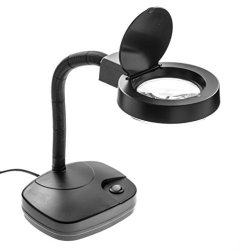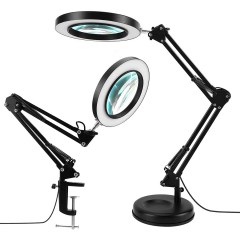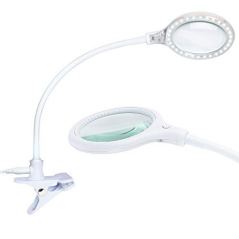BestReviews is reader-supported and may earn an affiliate commission. Details

This adjustable floor lamp is perfect for hobbies whether you're sitting or standing.
A tall floor lamp that can easily be adjusted for sitting or standing. The lens has a focal range of 15 inches and LED lights with a brightness of 450 lumens. Features a 3-diopter lens and two color choices.
The base is very heavy, making this lamp difficult to move.

At a price far lower than its competitors, this is a simple lamp with a 3.5-times magnifying lens.
This lamp's light is easy on the eyes, making it a good choice for long stretches of work. The flat base makes it great for working at a desk. The arm measures 12 inches, and two color options are available. Overall, this is a good lamp at a great price.
The base is too light to consistently keep the lamp from tipping.

With adjustable swing arms and the option to mount it with a base or clamp, this option provides users with a high degree of flexibility.
Brightness can be easily changed from 10% to 100% with a high of around 960 lumens. Three color modes and 2.25x magnification. LED lamp. Spring-controlled swing arms and lens can tilt 360 degrees. Several mounting choices.
The base is not heavy enough to fully extend the arms. Consider adding some weight to it to prevent tipping.

An affordable floor lamp with an adjustable neck.
This is a great affordable option as far as floor lamps go. The base is heavy enough to keep the lamp from tipping, and the gooseneck is easy to adjust. Features a 5-inch lens with 4 diopter magnification.
The light is dim and was tough on the eyes for some customers.

A good clamp design at a lower price than the V-Light.
Sleek design and a powerful LED. We love the brightness of this little lamp and its use for crafting and working on details. Features 570 lumens and 1.75-times magnification lens.
The bendable arm is fairly short at 12 inches.

We recommend these products based on an intensive research process that's designed to cut through the noise and find the top products in this space. Guided by experts, we spend hours looking into the factors that matter, to bring you these selections.

Sometimes your eyes alone aren’t enough. Whether your work involves materials and objects that require added magnification or your hobby and crafts projects have started to blur over time, we could all use a bit more magnification and light on occasion.
A magnifying lamp, with its combination of both a magnifying glass and a powerful lamp, may be just the tool to bring all your projects into a clearer focus.
To successfully find the magnifying lamp for you, you'll want to consider a few things, like specs such as focal length, brightness, and magnification level as well as features like the lens and base.

There are two general types of magnifying lamps to choose from: desktop magnifying lamps and floor magnifying lamps. Desktop magnifying lamps have a shorter neck, usually 12 to 15 inches long. This type of lamp often features a clamp or clip that you can use to secure the lamp to a shelf or the edge of a desk. Desktop magnifying lamps are usually lighter and more portable.
As you might expect, floor magnifying lamps have a longer neck and sit on the floor. These tend to have a heavy base to prevent tipping, making them less easy to move around or take on the road.
The focal length of a magnifying lamp is the amount of distance between the lens and the object you are viewing when it is in focus. Lens magnification is a big factor in focal length, which can be a significant issue if space is tight where you are using the lamp. Focal length can vary, with the average being around 12 to 15 inches.
Magnification is obviously a primary consideration with magnifying lamps. Magnification can range considerably from lamp to lamp, from a low of under 2x up to 10x or more. The average magnification for magnifying lamps is around 5x. The higher the number, the more powerful the magnification. Some magnifying lamps include a way to adjust the magnification, which you can use to focus on different tasks and projects.
When looking for a magnifying lamp, consider your own eyesight’s strength and limitations carefully to determine what magnification you need.
In addition to magnification, a magnifying lamp’s light is another primary factor. Bulbs can range from LEDs to fluorescents to even halogens. If you plan to use your magnifying lamp for hours at a time, the light it produces can be a big factor in eliminating eye strain.
Magnifying lamps start out at around 350 lumens and can reach upward of 2,200 lumens or more. Some magnifying lamps include controls so you can adjust the brightness level to better meet your needs or even change color modes from cooler to warmer light.
Some magnifying lamps are primarily constructed from metal, while others go with a much higher ratio of other materials such as plastic. If you have durability in mind, stick to metal magnifying lamps.
Lamps in general typically fail because they are knocked over, so avoiding this will lead to longer lamp life. If the magnifying lamp features a clip mount, be sure that it is sturdy and won’t slip on its own. If you have a lamp with a base, verify that the base is flat and heavy enough to keep the lamp upright.
While the majority of magnifying lamps are powered via a cord plugged into a standard wall outlet, some also include a disposable or rechargeable battery option. If the lamp does include a battery option, this can open up the use of the lamp to areas without a power source.
When selecting a magnifying lamp, you should take cord length into consideration (too short and you’ll need an extension cord), in addition to how often you will need to swap out or recharge the batteries.

The more adjustable a magnifying lamp is, the more flexibility you will have in how you use it. While both desktop and floor magnifying lamps typically have twistable necks (and sometimes necks that can be adjusted for height), clamp-on lamps will often feature spring-controlled necks that can be raised, lowered, or rotated. All magnifying lamps should have swivel heads, with the best capable of 360 degrees of rotation.
The lenses of magnifying lamps can be glass, acrylic, or plastic. We recommend sticking with a high-quality glass lens. Glass not only provides better clarity, but it is also less likely to warp or become scratched. A glass lens will last longer than a lens made from other materials.
Two numbers you will need to consider when comparing lenses are the diameter and diopter. The diameter of lenses can vary in these lamps, usually ranging from 3 to 6 inches or more. While magnification can be a big factor, in general, the larger the diameter of the lens, the larger the object you can use it with. The diopter – or thickness – can also vary, with the majority of lenses falling in the range of 3 to 5. The higher the diopter, the thicker the lens and the more magnification you’ll have.
Some magnifying lamps include a lens cover, which can be useful for keeping the lens dust-free. These are usually flip covers that attach to the lens housing and can be raised or lowered as needed.
Magnifying lamps usually have either weighted bases or clamps. Some ship with both options, although this is rare. For solid bases, weight is a key component. The heavier the base, the less likely the lamp will tip or fall over. However, a base that is too heavy can also result in a lamp that is difficult to move or even reposition. All solid bases should be flat on the bottom for stability. Clamps should be rugged and strong enough to hold the magnifying lamp securely.
Clamp-on magnifying lamps are sometimes much more compact, so you can use them on a clipboard or book.
Inexpensive: Magnifying lamps start out at around $20 to $30. In this range, you will find less bright options, often under 500 lumens. Lenses are typically around 3 inches in diameter and are often made from acrylic or plastic. Lamps in this range are often smaller desktop magnifying lamps with solid bases.
Mid-range: In the $30 to $50 price range, you will find larger desktop lamps, some with a clamp-on base. Lenses here are larger, often 3.5 to 5 inches in diameter. Bulbs are a brighter 500 to 1,500 lumens on average in this range, and some lamps include a battery option.
Expensive: For serious crafters and hobbyists and those who use magnifying lamps in their work, the $50 to $100-plus range will be the best fit. Magnifying lamps here feature 5-inch-plus lenses, a brightness typically in the 1,500-plus lumens range, and a greater degree of adjustability than less expensive lamps. Floor magnifying lamps and lamps with a robust battery option are common here.


Q. How easy are magnifying lamps to assemble and install?
A. Magnifying lamps typically ship fully assembled or nearly so. Any assembly required will generally be fairly light. Installation can vary a bit, depending on what type of lamp you go with. If you choose a desktop magnifying lamp, the installation will usually be as simple as clearing a space for the lamp and plugging it in. Floor magnifying lamps will be similar. You may run into some slight issues with clamp-on bases, as some of these can be a bit tricky to figure out right out of the box. You will also need to take into account the amount of space a swing-arm clamp-on lamp will need if you plan to utilize its full range of motion.
Q. What type of light bulb should I go with?
A. Magnifying lamps typically use one of three different types of bulbs: LED, fluorescent, or halogen.
Q. Where can I find replacement bulbs for magnifying lamps?
A. Any magnifying lamp you get should ship with a bulb, so you should be set for a while. Still, bulbs do blow out, and finding a replacement can be difficult for specialty lamps of this type. Your best option is to go back to the original seller. The seller may also carry replacement bulbs, or the listing may indicate what type of bulb you will need. Locally, you can try hardware stores that feature a robust lighting department. You can also try doing an online search on the bulb type or on the number printed on the bulb itself.
Get emails you’ll love.
Learn about the products you’re wondering if you should buy and get advice on using your latest purchases.
